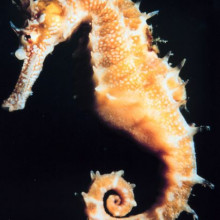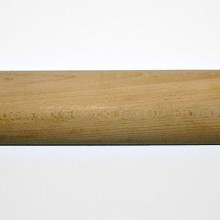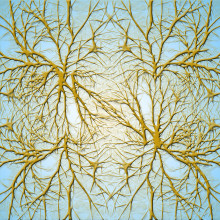Combining virtual reality and treadmills to map navigation in the brain. We ask how starlings flock in such a synchronised murmuration. And in the news, inducing creativity by electrically tweaking human brains, how video games could help national security, plus we find out what's been keeping Professor Gage up all night!
In this episode

01:28 - Mapping navigation in the brain
Mapping navigation in the brain
with Professor John O'Keefe, University College London
Professor John O'Keefe discusses how researchers are combining virtual reality and treadmills to map navigation in the brain.
Hannah - Kicking off the programme, let's map our way around the brain. Arguably, the most important structure for navigation is the hippocampus. So, let's kick start with some facts about it.
The hippocampus is buried deep within your brain. It's shaped like a  seahorse which is why it's called the hippocampus from the Greek meaning curved horse, and there's one hippocampus on each side of the brain. Each one is just smaller than the size of your curled little finger, and each one is packed with about 40 million nerve cells. Each of these cells can be connected with up to 10,000 others, so it's essentially a very complicated circuit board sending spikes of electrical information in the region and to other parts of the brain. Why does it do this? To help you find your way around the world, learn your place in it and let you process where you want to go.
seahorse which is why it's called the hippocampus from the Greek meaning curved horse, and there's one hippocampus on each side of the brain. Each one is just smaller than the size of your curled little finger, and each one is packed with about 40 million nerve cells. Each of these cells can be connected with up to 10,000 others, so it's essentially a very complicated circuit board sending spikes of electrical information in the region and to other parts of the brain. Why does it do this? To help you find your way around the world, learn your place in it and let you process where you want to go.
But how exactly do all of these cells work together to do this? I spoke to Professor John O'Keefe from University College London......
John - What's happening now, and what's very exciting in the field, is that we're now beginning to gain the tools (to study navigation). With an artificial virtual reality environment we can begin to assess exactly what cues and what stimuli in the environment are causing the cells to fire in particular places. So, we're optimistic that in the near future, coupling virtual reality environments to new recording techniques, we'll be able to record from large numbers of cells and to see how the cells are interacting with each other.
 Hannah - So, we've got particular cells and they all seem to work together in order for us to have an idea of where we are and even where we may want to go. What signals are coming into the brain in order to help change the activity of those cells? Are there particular things like reward or pleasure that might affect those cells in the hippocampus?
Hannah - So, we've got particular cells and they all seem to work together in order for us to have an idea of where we are and even where we may want to go. What signals are coming into the brain in order to help change the activity of those cells? Are there particular things like reward or pleasure that might affect those cells in the hippocampus?
John - That's a very good question and there is not simple answer. The hippocampus is located very far away from the sensory inputs and is quite a bit away from the motor outputs. We do know anatomically that it receives information from many different areas of the sensory, neocortex and under certain circumstances, it's been demonstrated that the cells are capable of using any combination of sensory inputs that are available to the animal.
Hannah - And is the hippocampal formation made up of other cells? They're not just these navigation to cells. Are there other cells in the hippocampus?
John - So that's a contentious question and over the years, there have been reports that there are other cell types in the hippocampus. However, if you take an animal, put it into a succession of different environments, you will find that there are cells in the second environment which didn't respond in the first environment. And there are cells in the third environment which didn't respond in the first two environments. So that when you place the animal into a multitude of environments and certainly, by the time you placed into say, 6 or 7 environments, you will find that the majority of cells in the hippocampus have a place response location field in one of those environments.
Hannah - So, if the majority of these cells within the hippocampal  formation are involved in spatial navigation and people with Alzheimer's for example, find it very difficult to navigate their way around, particularly, new environments and they have less connections between cells in the hippocampus, and they also have cell death in this region. Could this be a reason why?
formation are involved in spatial navigation and people with Alzheimer's for example, find it very difficult to navigate their way around, particularly, new environments and they have less connections between cells in the hippocampus, and they also have cell death in this region. Could this be a reason why?
John - Well, yes. There are two questions really that you're asking. One is, what's the relationship between the human hippocampus and the animal hippocampus? And the other is, how much of the human hippocampus is involved in functions similar to say, those in the hippocampus in the rat? And the story isn't a simple one. It's clear that in humans, the hippocampus is involved in other types of memory and other types of processes in addition to special processes.
Our own thinking, and I guess the simplest way of characterising this is that the human hippocampus is involved in what we call episodic memory. That is the memory for what you did at a particular time in a particular place. Now, our own thinking is that this is an extension of the special functions of the animal hippocampus. So, as well as being primarily a spatial memory system also processes information about the time at which the animal went into the location and what it did in that location. If you put those together, you have the beginnings of what we would call - if we were looking at the human memory - an episodic memory system.
And it's known that one of the first things that go wrong early of Alzheimer's disease is both deficits in their navigation ability and also, they tend to get lost in familiar environments, and also, their episodic memory system. So, we think that your hypothesis could be right, that you could demonstrate a relationship between the function and the loss of function in the hippocampus, and deficits in spatial and more broadly episodic memory is a very good one.
We have looked at the changes in these cells in a mouse model of Alzheimer's disease and we do in fact see that the mice, as they get older - not when they're younger, but as they get older, they show changes in their spatial memory ability and that these changes are very highly correlated with changes in the function of the hippocampal place cells and also incidentally, with the accumulation of plaque where the typical Alzheimer plaque burden which is seen in patients with Alzheimer's disease.
Hannah - That was Professor John O'Keefe from University College London.

Can I improve my navigation skills?
Hannah - I believe that you were involved with some work with Eleanor Maguire, looking at taxi drivers and their ability to navigate their way around really complicated, convoluted roadway systems in London for example, and how their brain might have changed as a result of the training they experienced in navigating their way through London? Hugo - Yes, that's right. It was fascinating when Eleanor Maguire discovered that London taxi drivers, the ones that drive the black cabs, actually have an enlarged posterior hippocampus and a shrunken anterior hippocampus as part of the job. So, we compared their brain structure to a normal healthy person who's not a taxi driver. She found all these differences. The posterior end of the taxi drivers seemed to expand. And so, it's fascinating to see that longer they had driven a taxi in London, the larger their hippocampus became. It was interesting to see it expand physically, but what is it actually used for? We presume it's involved in spatial navigation, but we're quite keen to tie down when. So, to do that, we got hold of a simulation of London which was available at that time on the Play Station II. There's a game called the Getaway to simulate the extent of driving through London and so, we're able to have London taxi drivers drive through and do their job on a regular basis, but in a controlled virtual setting. Because it was on a computer screen, we could also examine what's going on inside their brain while they're driving using functional magnetic resonance imaging. So, what we found doing that because the taxi drivers really used their hippocampus maximally when they're first thinking where to go when you get on a taxi and you give the taxi driver a destination. That's when they'll be using their hippocampus, but once they've done that and they see these themselves on neuroimaging data, backed up what they had to say, they kind of switch off. They don't really think. They go on to automatic pilot and they just get you there. Other bits of the brain sort of takeover and do all sorts of fine-tuning, and so on. But what we found, the hippocampus was really key in that initial moment of planning a route.
Hannah - So, going back to Dave Collier's point, it may be that he could exercise his hippocampus by testing himself with new navigation and new routes?
Hugo - That's right. There is some evidence. If Dave left his books and went off and played a video game. In fact, went out of his office perhaps even better every day to navigate through a new bit of city or environment, it's quite possible he might expand his hippocampus as a consequence.

How do birds fly in a flock?
We posed this question to hippocampal researcher Dr Hugo Spiers from University College London.
Hugo - Paul is right to ask about it. It's really interesting. If you think about animals navigating as they travel over the Earth from one point to another, they do have to synchronise their movements. They don't knock each other in the air, but it's less of a navigation question. Actually, it's more of a coordinated motor problem. But I guess, the key thing is how do they know that the bird at the front is going in the right direction? And do they all decide the direction like a voting system to make the flock go in the right direction? There must be something going on there. Very hard to study, certainly, very hard to get at the neuroscience how their brain does that.
Hannah - Thanks, Hugo and if you've got any burning questions about your brain and the nervous system, just email them to neuroscience@thenakedscientists.com, you can tweet us @nakedneuroscience, or you can post on our Facebook page, and we'll do our best to answer them for you.

12:22 - Picking out features in a crowd
Picking out features in a crowd
PhD Students, David Weston from Cambridge University describes his top papers of the month!
David - The first paper this week ties into the podcast's theme of navigation. Researchers from the University of Toronto have just published evidence that playing action-based video games can improve your ability to navigate your environment, specifically your ability to pick out features in a crowd.
Sijing Wu and Ian Spence, in the journal Attention, Perception & Psychophysics showed that people who played action games such as Call of Duty, Counter Stroke and Halo, so called First-Person-Shooter or FPS players, for at least 4 hours a week in the previous six months were much faster at finding specific objects in a typical visual search task. The FPS players were also more accurate at identifying objects in their peripheral vision when taking on tasks in their central vision.
These results collectively suggested that FPS players are better at searching visual scenes and splitting their attention across their visual field. These experiments used self-confessed action video game players but what the authors of the paper really wanted to know, was whether their abilities were trainable, ie. Can playing video games make a non-player better at these tasks?
A group of 60 students, who didn't have any experience with video games were split into groups and given different video games to play: two groups were given action video games and a third group was given a 3D puzzle game. All of the participants were asked to play the video games for 10 hours, as part of their training.
The results showed that even after only 10 hours of training the  participants who played the two action games showed remarkable improvements in their visual search abilities, compared to those given the puzzle game. Although these experiments may seem trivial the investigators highlighted the importance of these findings. We use searching behaviours in many critical aspects of life from looking for a face in a crowd to poring over complex MRI scans. Using video games may be a great way to train people's visual searching skills! Sounds like a fun way to train to me!
participants who played the two action games showed remarkable improvements in their visual search abilities, compared to those given the puzzle game. Although these experiments may seem trivial the investigators highlighted the importance of these findings. We use searching behaviours in many critical aspects of life from looking for a face in a crowd to poring over complex MRI scans. Using video games may be a great way to train people's visual searching skills! Sounds like a fun way to train to me!
Wu & Spence. Playing shooter and driving videogames improves top-down guidance in visual search. Attention, Perception, & Psychophysics, March 2013.
http - //link.springer.com/article/10.3758%2Fs13414-013-0440-2

14:21 - Getting creative!
Getting creative!
Hannah - So, my top paper for month is to do with electrically tweaking brains to induce creativity and been published in the Journal of Cognitive Neuroscience by Sharon Thompson-Schill and her colleagues at the University of Pennsylvania.
So, they did this really quite neat experiment. They took 48 volunteers and they presented them with everyday objects.
In fact actually David, I'm going to make you one of the volunteers for this experiment. I'm going to present you with an everyday object. I'm going to ask you to tell us what it is and what you would do with it, and then I want you to think outside the box, and just off the top of your head, tell me other things that you could do with this particular object. Ready? So, I'm presenting David with a picture of - I'm going to turn on a piece of paper now. David, what is this and what would you do with it?
David - It's a rolling pin and I guess you'd bake with it, so you can roll  out pastry. That's the kind of conventional task I guess.
out pastry. That's the kind of conventional task I guess.
Hannah - And so, what else could you use it for outside the kitchen?
David - Well, you could hit someone over the head with it, you could use it as a rounder's bat, if you heat it up, you could use it as an iron. If it's made of wood, you could burn it and have it as a source of heat.
Hannah - So, would you say that you're creative?
David - I don't know. Not really. I find it very difficult to come up with those out-of-the-box solutions right on the spot there like that, but I came up with some reasonable ones, I think.
Hannah - Yeah, I think you did pretty well.
So, what the researchers that published this paper wanted to do was, they wanted to find out if they could make people more creative. So, come up with more out-of-the-box creative ways of using that rolling pin or other devices. So, in order to foster creativity in their volunteers, they decided to electrically shock, apply a small electric current, just 1.5 milliamps or 1.5 thousandth of an amp of current to the left side of their brains and also had a control group where they applied the same current to the right side of the front of the brain, and also, a control group that just had this placebo effect. So, they just had a very small electric stimulus right in the middle, just for a very small amount of time.
David - So, why would you want to look at the left versus right side of the brain? What's the impetus for doing that?
Hannah - So, they were stimulating the pre-frontal cortex, the bit just behind your forehead that's involved in cognitive thoughts - so learning, reasoning, planning, flexibility, and thought. And the left side of the brain, the left hemisphere is thought to be involved in more linear kind of thought and the right side is thought to be involved in more kind of global kind of creative thinking.
David - So, what did the researchers find from this experiment.
Hannah - Well amazingly, they did see quite a dramatic increase in the creativity as measured by the task that we just demonstrated, when they were applying a small inhibitory electrical current to the left side of the brain - so, by inhibiting the left pre-frontal cortex, they actually fostered more creativity in these volunteers.
David - So, what does that tell us about the way that the brain is setup to come up with creative ideas then?
Hannah - Scientists think that the pre-frontal cortex and in particular, the left side is usually involved in filtering information and kind of dampening down how your brain works. So, this study really unifies that hypothesis.
David - Excellent! That's really interesting.
Hannah - So, do you think we should all wander around with little electrical thought caps on our heads when we need to be creative?
David - Maybe and I was thinking a lot of kind of companies seem to value people who can think outside the box. So, I'm interested to see what the implications of this kind of research would have on how people view creativity and whether you can force somebody to be creative when they don't think they are.
Hannah - Hummm, maybe teachers can bring it into art classes?
David - Yeah, it would certainly make me better at art, I think!

17:31 - Locating the GPS system in the brain
Locating the GPS system in the brain
PhD student David Weston reports on his top stories for the month....
David - The second paper this week marks a significant milestone for brain navigation research. A group of scientists at Princeton University have been working towards locating the human GPS system, an area of the brain that is responsible for allowing us to successfully navigate our environment.
David Tank and his team focused on the medial entorhinal cortex, an area of the brain that has previously been associated with the way in which we map physical space.
Within the entorhinal cortex we find neurons called grid cells that fire electrical signals at particular places within the space. Remarkably these grid cells form a pattern of activation that looks like the hexagonal spaces on a Chinese Checkers board. So a single grid cell will fire when you occupy specific hexagons within a room for example.
Now two competing theories have predicted how these grid cells electrically encode the physical landscape. The first, the so-called oscillatory interference model, proposes that individuals grid cells produce oscillations in their electrical activity that inform you of where you are, while the competing attractor model suggests that the ramping electrical patterns of grid cells, communicating with one another, are responsible for the positional information.
The authors decided to test which of these theories is most valid by taking electrical recordings from the entorhinal cortices of mice navigating a virtual-reality environment. Although they found that both the oscillations and ramps were present in these cells, the ramping electrical activity much more reliably predicted the positional information, giving support to the attractor model.
These important findings have come some way into understanding how the complex patterns of electrical activity in the brain co-ordinate to give us reliable and accurate information about the ways in which we can interact with our world.

20:10 - How did you beat addiction?
How did you beat addiction?
with Anonymous, Squeaky Gate student
 Hannah - Moving to the back of a bus, where I'm returning from the Royal Albert Hall with the Cambridge based music charity, Squeaky Gate, that I volunteer with, having just performed live as part of a series of concerts to help destigmatise mental health issues.
Hannah - Moving to the back of a bus, where I'm returning from the Royal Albert Hall with the Cambridge based music charity, Squeaky Gate, that I volunteer with, having just performed live as part of a series of concerts to help destigmatise mental health issues.
I'm speaking with one of the anonymous lead vocalists about his experiences with addiction, a condition that also involves the hippocampus.
Male - I discovered alcohol at 15 and it seemed to turn the lights on in my head and it did everything that I wanted it to do.
It gave me confidence. It enabled me to talk to people. At first, it was just going to pubs just like everybody else, socialising and it was fun.
It led to 27 hospital visits, 17 detox visits, various psychiatric evaluations. It eventually led to me throwing up 4 pints of blood because I had the blood vessels in my throat burst.
I remember coming back from that experience, and I went back to alcoholics anonymous and for the first time, I opened my ears and I listened. I sat and I listened, and discovered the reasons why I was doing what I was doing.
So, I went to old pubs that I used to drink in, I just forced myself to walk in and either just stand in them or occasionally, I would speak to a couple of people that are still there, and just rewrote a different memory. I walked out and I've never been back.
Hannah - Next, we meet up with a scientist to find out about a new treatment for addiction and posttraumatic stress disorder to find out more about re-writing the script in your brain.

21:43 - Eternal sunshine on a spotless mind?
Eternal sunshine on a spotless mind?
with Professor Barry Everitt, Cambridge University
Hannah - Next, we meet up with a scientist to find out about a new treatment for addiction and posttraumatic stress disorder.
Barry - I'm Barry Everitt. I'm a Professor of Behavioural Neuroscience in the Department of Experimental Psychology at the University of Cambridge.
Hannah - Hello, Barry. So, we've just been talking to somebody who experienced quite severe addiction for a number of years and he spoke about overcoming his addiction and rewriting the script as it were, so removing associations that he had whether it be particular environment, particular social situations, with his addiction to alcohol. I wondered if you could tell us a little bit about the research that's going on in this area of rewriting the script in your brain.
Barry - Yes and that's an interesting thing that this person has done.  So, when people begin taking drugs and then make a transition to becoming addicted to them, what happens is, generally, they take their drugs in a very ritualistic way in a very restricted range of environment, and in the presence of rather few specific stimuli that are related to their drug taking, obviously, for drinking alcohol is often in bars and with certain people, and it's true for people taking cocaine as well. They have certain kinds of equipment that they use in certain places, sometimes with certain people.
So, when people begin taking drugs and then make a transition to becoming addicted to them, what happens is, generally, they take their drugs in a very ritualistic way in a very restricted range of environment, and in the presence of rather few specific stimuli that are related to their drug taking, obviously, for drinking alcohol is often in bars and with certain people, and it's true for people taking cocaine as well. They have certain kinds of equipment that they use in certain places, sometimes with certain people.
And quite naturally, those stimuli become associated with the effects of taking the drug or drinking alcohol through a learning process that we've known about for well over a hundred years called Pavlovian conditioning and everybody remembers about Pavlov's dogs and bells, and salivation. So, a restricted range of otherwise innocuous stimuli in the environment become alcohol cues or cocaine cues, or heroine cues.
Now, it turns out what we've come to understand from our work and others in a clinical situation is those stimuli become very, very significant in the course of addiction because they can evoke craving.
Hannah - So, if somebody may have gotten over the physiological addiction to the particular drug and then after that, there's a second wave where they have to get over this association with the habit?
over this association with the habit?
Barry - Yes. In fact, you don't ever really unlearn those associations except recent research has suggested that it might be possible to unlearn or eradicate their meaning.
Now, this has been known for many years in some treatment centres for addiction where clinicians have used something called cue exposure therapy. So here, what happens is that people seeking to become abstinent - for example, to stop drinking - go in to the clinic through questioning and discussion, their particular cues are identified, and those are presented repeatedly, but without alcohol and this is what the person you were describing earlier has been doing by visiting places where he used to drink, but hasn't drunk. And so, you keep repeating over and over again, presentation of these cues and it turns out that they elicit less and less, and less craving whether you measure that in terms of how people feel or you measure some objective - physiological measure like their heart rate or their skin conduction, a measure of some sweating on the palms.
And this process in psychology is called extinction. Now, that's all well and good, but it turns out that extinction is very context or situation dependent.
So, if you bring somebody to the clinic, extinguish those cues so they're not responding to them. When they go back out into the real world and encounter those same cues, but in the context in which their normally present, you find they haven't been extinguished at all. So, it's not a very successful treatment.
Hannah - So, it's a bit like taking someone into the clinic and presenting them maybe with some beer bottles or particular advertising associated with alcohol which is a very different situation to meeting up with your friends on a Friday night in a restaurant where there's wine or there's beer available?
Barry - Exactly so. So, how do you get over that? A couple of things have happened recently which have suggested that the memories elicited by drug-associated stimuli, drug use, can indeed be erased, and this was a big surprise when it was appreciated in about 2000.
When you retrieve a memory in the point where the memory is active again, and in the case of drugs, when the cue has elicited your memories of drinking and cause you to crave, that memory becomes labile in a new active and transient state in the brain neurochemically. It has to be re-stabilised in the brain.
It turns out through another round of protein synthesis in cells in the brain, and that's kind of, but not exactly the same as, the process that would've occurred when those memories are being formed in the first place. So, we talk about consolidating new learning to form memories and this process where the memory becomes plastic and must be re-stabilised to gain a retrieval, it's called reconsolidation.
Hannah - And so, that reconsolidation of the memory that point when the memory is quite labile and quite plastic may be a point where therapeutically, you could intervene and start some kind of treatment to dissociate that habit, that association with the drug?
Barry - Exactly, right. Now, it turns out that a very common drug used to treat hypertension, propranolol which is a beta receptor blocker can block that reconsolidation, that re-stabilisation process.
So, if you retrieve a memory in the presence of a beta receptor blocker and then come back and look a day or a weak or a month later, you find that memory has been erased.
Now, that's being translated to a clinical setting in the case of posttraumatic stress disorder, people who are greatly affected by horrific and intrusive memories of terrible events like war or accidents, or rape, and it turns out if you retrieve the memory under beta receptor blockade, not just once but two or three times, there's an enormous reduction in the intrusiveness of the memory and people are much less bothered by it.
Now, that particular approach to treatment hasn't yet been applied to drug addiction, but it's something we are planning to do here in our alcohol study.
Hannah - And how do you make sure that you're not going to be erasing any other memories at the same time whilst administering this beta blocker because that must be a bit of a concern that you would erase a person's memory?
Barry - Like the eternal sunshine of the spotless mind, that's one of those fears that people always bring up, but actually, the conditions under which you can make the memory labile and can influence it are incredibly precisely defined. So, you would only ever be able to modulate a memory by focusing on the conditions specific to that memory and reactivating it.
Hannah - And which areas of the brain are these memories, these associations, being affected by the beta blocker?
Barry - The amygdala which is well-known to be associated with emotional learning and memory. It is certainly the case for drug cue and fear cue memories, but also the hippocampus which is much more to do with spaces and places, and contextual memories.
So, that's a treatment that's based on something that is now called reconsolidation blockade, but it's also the case that in the last couple of years, it's become clear that you can take the first process that I spoke about which is extinction and the second process I spoke about which is reconsolidation and put them together because they interact in a very interesting and unexpected way.
Now, what's recently being investigated in the very exciting way is that if you briefly retrieve a memory and then wait a little while, 10 minutes or an hour, and then do extinction, that combination of brief retrieval delay extinction training, actually results in the true erasure of the memory, particularly if it's done perhaps on a couple of three times, and the memory never spontaneously recovers. You can never cue it back into existence again.
Now, that combination of treatments has been done experimentally in a drug setting, in a lab in China, and this was published in Science. And there, they've taken heroin addicts and brought them into a treatment centre, briefly exposed them to heroin cues to retrieve the memory, they've waited a little while and then taken them through extinction training room. They've done that two or three times and discovered that subsequently, those cues have lost their ability to elicit craving and they've lost their ability to activate the physiological measures of the impact of those cues in terms of reduced heart rates and reduced sweating skin conductance.
Hannah - And do you think that holds promising in terms of translating into the real world situation where you have more of these social cue?
Barry - The evidence is, that reconsolidation blockade and this extinction following brief memory retrieval which some people call super extinction is not constrained by context. So, you can do it in one place and it transfers to other places. So, that's really quite an exciting development because it suggests you could take advantage of what already goes on.
For example, in the treatment of PTSD or phobias you would conduct a normal cognitive behavioural therapy session where you'd bring someone in and actually go through an extinction process, but you do it under these conditions of brief memory retrieval followed by extinction. In a consultation, there's already going on, just a subtle change in the way you conduct it and it might have a profound impact on the success of the extinction training.
Hannah - That was Professor Barry Everitt from Cambridge University.

28:05 - What keeps a Californian Prof up?
What keeps a Californian Prof up?
with Professor Fred Gage, Salk Institute, California
And closing this month's show, Professor Fred Gage from the Salk Institute California describes what's been keeping him up all night. Fred also researches the hippocampus, looking at a specific area of it, called the dentate gyrus. This region is one of the few brain areas that c ontinues to get new brain cells being born throughout life.
ontinues to get new brain cells being born throughout life.
Fred - One of the things that I find remarkable right this minute, there are a lot of things, but there are individual differences between neurons of the same brain structure. So here, we're talking about the dentate gyrus of the hippocampus and that first pass, it looks like all these cells are exactly the same and in another area of the hippocampus called the CA1, there are pyramidal neurons and they look all the same. But if you go in and record from those cells individually or you go look at the expression patterns of RNA or even if you look at the DNA of those cells, they're different. All are different and the next wave of interest I predict will be looking at these individual differences that occur between individual neurons within the brain.
Hannah - That was Professor Fred Gage from the Salk Institute California. That's all for now. I'll be back again next month to pay attention to ADHD - Attention Deficit Hyperactivity Disorder.










Comments
Add a comment